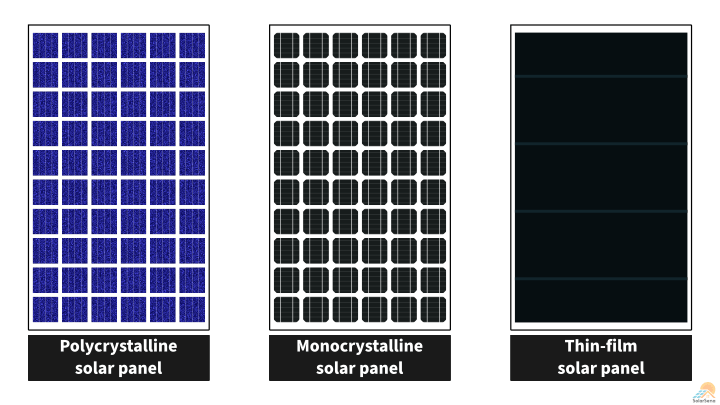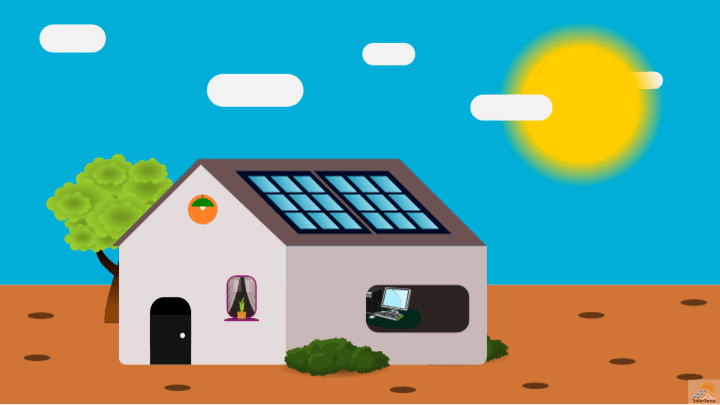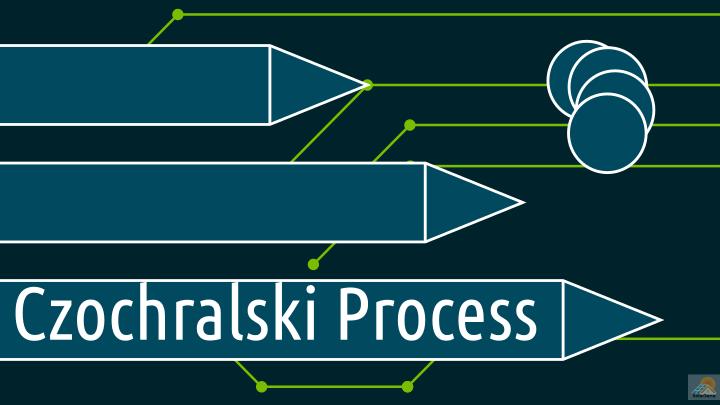The solar industry is booming in the United States. In 2019, the US had seen a 22.5% growth in residential solar installation. Due to the rising electricity cost and climate change, more American homeowners and businesses have opted for solar. And more people will move toward renewables in the coming years. For people looking for solar, it is worth understanding different types of solar panels and which is right for you.
A quick comparison of different types of solar panels
Most solar panels in the market can be categorized into three major types: polycrystalline solar panels, monocrystalline solar panels, and thin-film solar panels. They all differ from one another in look, performance, efficiency, and cost. Further, each one of them has its own advantages and disadvantages over others. So, there is no best of them, but rather the best depends on the specifics of your needs.
Of the three, the former two are very common and have a global combined market share of more than 80%, whereas the latter one is struggling to stay in the competition. Here is a quick comparison of all three with the advantages and disadvantages that will help you quickly grasp them.
| Property | Polycrystalline silicon solar panel | Monocrystalline silicon solar panel | Thin-film solar panel |
|---|---|---|---|
| Made from | Polycrystalline silicon | Monocrystalline silicon | Various materials |
| Cost | Moderate | High | Low |
| Efficiency | Moderate (< 20%) | High (> 20%) | Low ( < 15%) |
| Appearance | Unattractive | Aesthetic | Aesthetic |
| Lifespan | Long (> 25 years) | Long (> 25 years) | Moderate (< 20 years) |
| Weight | Heavy | Heavy | Lightweight |
| Stiffness | Rigid | Rigid | Portable and flexible |
The detailed explanation is followed in the subsequent sections.
Polycrystalline silicon solar panel
Polycrystalline silicon solar panels are made from polycrystalline silicon solar cells—see the figure below. These solar cells are real energy converters; they convert solar energy into electrical energy. The number of solar cells in a panel can vary, but typical numbers are 60, 72, and 96.

The more cells are in a panel, the more energy it will produce, and the bigger it will get.
These solar cells are manufactured from the polycrystalline form of silicon, which is less expensive. That makes them cheaper than monocrystalline.
The material polycrystalline silicon is a high purity crystalline silicon with irregular grain boundaries. The irregularity in the structure creates nonhomogeneity in the material. Crystal properties, thermal properties, and electrical properties vary through the material. As a consequence, electrical charges suffer from resistance, which decreases the efficiency of the solar cells.
So, polycrystalline solar panels are less expensive, but they are also less efficient.
The efficiency of polycrystalline silicon solar panels goes between 15 and 18%. On the upper end, it could reach 19% for newer panels.
A usual thing people do not like about this type of solar panels is the look and color. They appear like crumpled blue plastic stretched on a metal frame. The look and color come from polycrystalline silicon.
Silicon is a reasonably stable element and one of the commonest in the earth’s crust. That makes polycrystalline silicon more durable. Modern polycrystalline silicon panels come with a life-warranty of 25+ years, which is a pretty good number of years.
Because of their rigidity and heaviness, they require more labor in lifting and handling them. It increases the installation cost.
Polycrystalline silicon panels are perfect for both roof-mount as well as ground-mount installations.
Nevertheless, they are traditional solar panels and continue to remain dominant in today’s market.
Monocrystalline silicon solar panel
Monocrystalline silicon solar panels consist of an assembly of monocrystalline silicon solar cells. These solar cells are very much similar to polycrystalline silicon solar cells since both are made from the same element, silicon. However, monocrystalline silicon is a totally different material. That is because it has no grain boundaries.

Monocrystalline silicon is a single-piece material. Unlike polycrystalline, there is no nonhomogeneity in the material. Each solar cell shows uniform crystal and electrical properties. Thus, electrical charges receive minimal resistance, maximizing energy transport. Monocrystalline solar panels have higher efficiency than polycrystalline. The efficiency is above 20% for brand-new panels. After a few years of use, the value does drop below 20%.
This higher efficiency does come at a higher price. Yes, monocrystalline panels are pretty expensive. To obtain single-piece monocrystalline silicon, manufacturers have to further process polycrystalline silicon, which pushes the cost of the material.
If you compare the same-sized monocrystalline with polycrystalline, monocrystalline solar panels perform better and give more wattage. It is a good thing, but we should not forget the high price of monocrystalline.
The homogeneity of monocrystalline is also reflected in its look and appearance. This type of solar panel gives a premium-like look and displays dark color. At a closer glance, you will not see any creases or crumples, like in polycrystalline. That is because the entire material is a single piece.
You can think of polycrystalline as flake ice and monocrystalline as an ice cube. Flake ice is a group of several irregular small pieces of ice, while an ice cube is a single-piece transparent frozen water.
Another distinguishing feature of this type of solar panel is the clipped corners of cells. All the four corners of cells get trimmed during the production. As a result, they get an octagonal shape.
They are long-lasting. Most manufacturers market with a warranty for 25+ years.
Similar to polycrystalline, they are heavy and rigid and used for both roof-mount and ground-mount installations.
Thin-film solar panel
Thin-film solar panels are very different from the above two and slightly difficult to describe. They are made by depositing thin films of various photovoltaic materials on a substrate.
Even though there are many variations in thin-film solar cells, three of them have become widely popular. And they are cadmium telluride (CdTe) solar cells, copper indium gallium selenide (CIGS) solar cells, and amorphous solar cells. Of three, the first one, CdTe, is more common than the other two.
As the name says, thin-film solar cells are very thin. Their thickness goes from nanometers to micrometers. Because of such slenderness, they are very lightweight and flexible.

This type of solar panel does not have any standardized sizes. In the market, you will find quite different varieties in the panels.
Another thing to note about thin-film panels is they are also available in a rigid form. Yes, if you interpose the thin film between two glass slabs, you get a stiff solar panel. But in that case, it will lose not only its flexibility but also its weightlessness.
The efficiency of thin-film solar panels is always less than 15%. Some lab studies do report higher efficiency. However, in the field, the value is between 9% and 13%.
If you look at the performance of thin-film panels, it will definitely not be as good as crystalline silicon. This type suffers from lower efficiencies and produces lower power. Needless to say, they are not a good option if you desire high-efficiency panels.
A primary advantage of thin-film technology is the cost. Thin-film technology is cheaper compared to the other two. Moreover, the manufacturing processes are more environmentally friendly in comparison with crystalline silicon solar panels.
The appearance and color of thin-film solar panels differ depending upon the material of construction. In general, they give a slick and appealing look, like monocrystalline.
The photovoltaic material of thin-film solar cells is not very durable. It degrades faster than crystalline silicon. Consequently, the lifespan of the panel decreases. It will be hard to expect the lifespan of the thin-film exceeding 20 years.
Which is the best type of solar panel for you?
There is no universal answer to it since all the types of solar panels have their benefits and shortcomings—rather depends on the specifics of your property and needs. The right type of solar panel will vary from person-to-person and property-to-property. It can also depend on your shape of roof, as a unique shape might require something like triangular panels or other weird shapes. There are also rollable solar panels which offer you more flexiblity than standard attaching panels.
For people and businesses who have an ample amount of roof space or ground space, polycrystalline solar panels are perfect. They are more affordable but less efficient than monocrystalline. We can cover the low efficiency of polycrystalline by installing more panels since you have plenty of open space for the installation.
Monocrystalline solar panels are also perfect for roof and ground-mount installations. However, we should also consider the cost of the project for this type. When space is a constraint, and you want to rely maximum on solar and minimum on power grids, monocrystalline panels are right for you. Besides the previous, if you are concerned with the appearance of your roof or structure, monocrystalline panels are the best in handling that.
Thin-film solar panels are flexible and portable, which makes ideal for curved surfaces. They are common in buildings. Constructors incorporate them with other building materials. We can laminate them on our windows, shading devices, and other suitable structures.
When the roof of your home is weak, it will not be able to bear heavy loads. Thin-film panels make an excellent choice in such situations. They are lightweight and will impose minimum force on your structure. You will not need to upgrade your roof.
Thin-film solar panels are the best choice for portable installations, for example, RVs, boats, cars.




